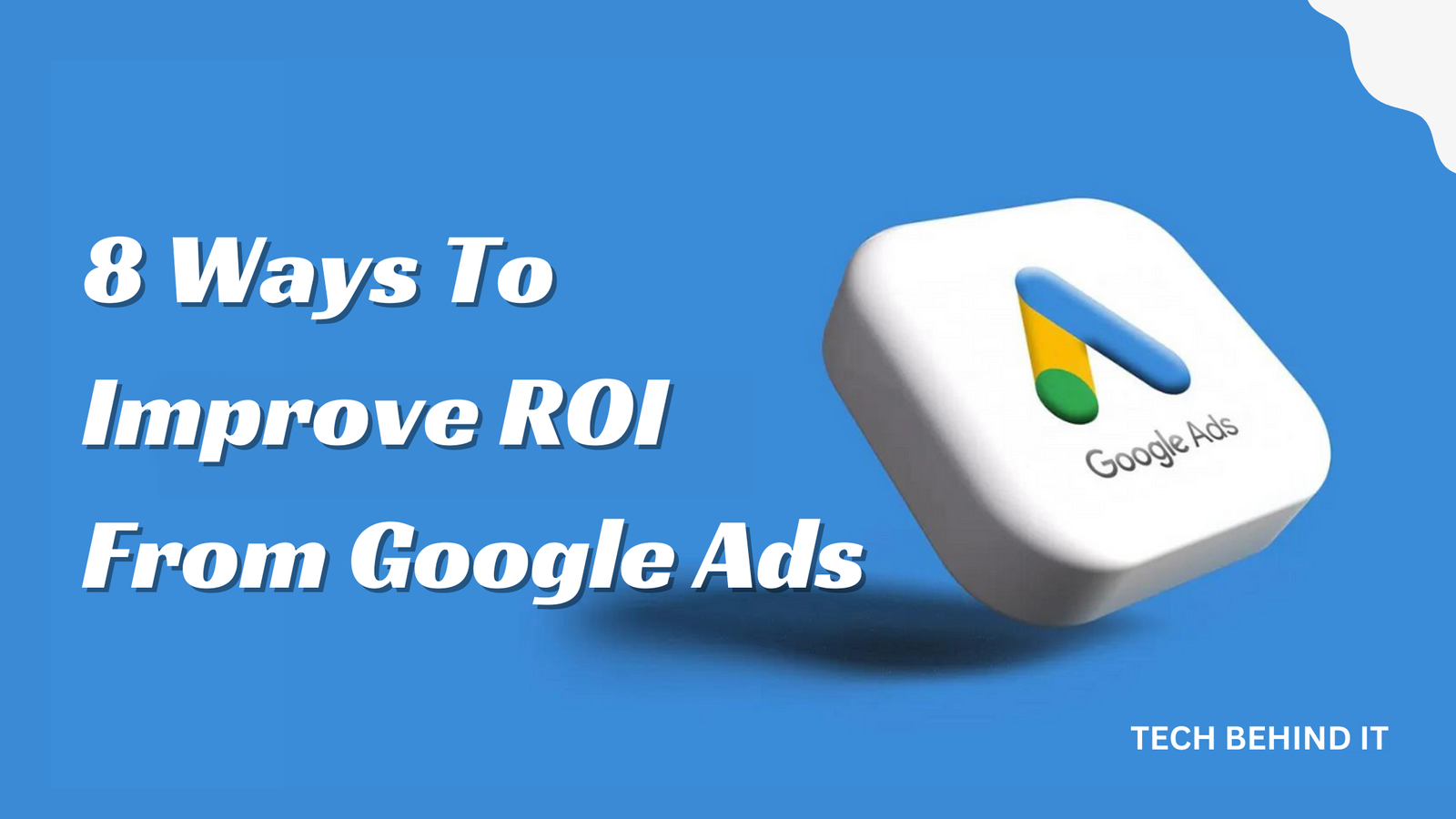8 Ways To Improve ROI From Google Ads
- 1 What is Google Ads ROI?
- 2 How to improve ROI from Google Ads?
- 2.1 1. Conduct Thorough Keyword Research
- 2.2 2. Create High-Quality Ad Copy
- 2.3 3. Optimize Landing Pages
- 2.4 4. Use Negative Keywords
- 2.5 5. Implement Ad Extensions
- 2.6 6. Leverage Remarketing
- 2.7 7. Monitor and Optimize Bids
- 2.8 8. Analyze and Refine Campaigns
- 3 Conclusion
Most Google Ad specialists believe that a static and free pay-per-click (PPC) campaign is enough for the survival of a business. However, that’s not the case. You must carefully evaluate all your campaigns and check which one needs investment. Most Google Ads management services cut down the most expensive campaigns. Doing this is like solving half of the question. To get a complete idea about the campaigns, you should know which will bring you more Return On Investment (ROI). To determine this, you need to know the Google Ads service. To understand what PPC ROI is all about, look at the below-mentioned points.
What is Google Ads ROI?
ROI is a critical metric for running a Google Ads campaign. They help you know which campaigns should receive more investment. In simpler terms, it means the amount of money you make instead of the amount you spend. Thus, ROI will help you know whether a campaign is worth an investment. You will also get to see the kind of profits you make. Dropping down campaigns if they bring in losses can also be possible using ROI. However, you should know that it does not calculate all the costs associated with selling your products, overhead, shipping amounts, etc.
How to improve ROI from Google Ads?
Once you know the importance of ROI, you can use it to improve your Google Ads game. Dropping a campaign is unnecessary if it is not doing well. Instead, there are multiple ways in which you can boost it. Below are a few tips that will help you improve your ROI from Google Ads.
1. Conduct Thorough Keyword Research
Keyword research is the cornerstone of any successful Google Ads campaign. Identifying the right keywords ensures your ads are shown to the most relevant audience. Here’s how to conduct adequate keyword research:
- Use Keyword Planner: Google’s Keyword Planner is a great tool for discovering new keywords and estimating search volume.
- Focus on Long-Tail Keywords: Long-tail keywords are less competitive and often more targeted, leading to higher conversion rates.
- Analyze Competitor Keywords: Tools like SEMrush or Ahrefs can help you understand which keywords your competitors target and how well they perform.
By investing time in thorough keyword research, you can ensure that your ads reach the right people at the right time.
2. Create High-Quality Ad Copy
The ad copy is the first thing users see, so it needs to be compelling. Effective ad copy increases click-through rates (CTR) and improves the overall performance of your campaign. Here are some tips:
- Highlight Benefits, Not Features: Focus on what benefits your product or service provides to the user.
- Use Strong Calls to Action (CTA): Phrases like “Buy Now,” “Get Started,” or “Learn More” encourage users to take action.
- Incorporate Keywords: Use your main keywords in the ad copy to make your ads more relevant to search queries.
Testing different versions of your ad copy can help you determine what resonates best with your audience.
3. Optimize Landing Pages
A user’s journey doesn’t end when they click on your ad. The landing page they arrive at is crucial in converting them into customers. Here’s how to optimize your landing pages:
- Ensure Relevance: The landing page content should match the ad copy and the user’s intent.
- Improve Load Speed: Fast-loading pages reduce bounce rates and improve user experience.
- Simplify Navigation: A clear, straightforward design with a visible CTA helps guide users towards conversion.
- A/B Testing: Regularly test different landing page elements (headlines, images, CTAs) to find what works best.
An optimized landing page can significantly increase your conversion rates and improve your ROI.
4. Use Negative Keywords
Negative keywords prevent your ads from showing up for irrelevant searches. By excluding these keywords, you can save money and increase the relevance of your ads. Here’s how to effectively use negative keywords:
- Identify Irrelevant Search Terms: Review the search terms report regularly to identify queries that aren’t relevant to your business.
- Add Negative Keywords: Use these irrelevant terms as negative keywords to refine your targeting.
- Ongoing Review: Monitor and update your negative keywords list to maintain ad relevance.
By filtering out unqualified traffic, you ensure that your budget is spent on potential customers more likely to convert.
5. Implement Ad Extensions
Ad extensions provide additional information and increase the visibility of your ads. They can improve your ad’s CTR and overall performance. Here are some popular ad extensions to consider:
- Sitelink Extensions: Direct users to specific pages on your website.
- Callout Extensions: Highlight unique selling points or special offers.
- Call Extensions: Allow users to call your business directly from the ad.
- Location Extensions: Show your business address and increase foot traffic to your physical store.
Using ad extensions makes your ads more informative and appealing, encouraging users to engage with them.
6. Leverage Remarketing
Remarketing targets users who have previously interacted with your website or ads. These users are already familiar with your brand, making them more likely to convert. Here’s how to use remarketing effectively:
- Create Specific Remarketing Lists: Segment users based on their behavior (e.g., visited a specific page, added items to cart but didn’t purchase).
- Tailor Your Ads: Use personalized ads that address your remarketing lists’ specific interests or behaviors.
- Adjust Bidding Strategy: Increase bids for remarketing audiences to ensure your ads are visible to these high-value users.
Remarketing helps you stay top-of-mind with potential customers and encourages them to return and complete their purchases.
7. Monitor and Optimize Bids
Effective bid management ensures that you’re getting the most out of your ad spend. Here’s how to optimize your bidding strategy:
- Use Automated Bidding Strategies: Google Ads offers various automated bidding strategies (e.g., Target CPA, Target ROAS) to help you achieve specific goals.
- Adjust Bids Based on Performance: Regularly review your campaign performance and adjust bids for keywords, demographics, and devices to maximize ROI.
- Set Bid Adjustments: Use bid adjustments to increase or decrease bids based on time of day, location, and audience segments.
You can continually refine your bidding strategy to improve your ad placement and reduce wasted spend.
8. Analyze and Refine Campaigns
Continuous analysis and refinement are essential for improving your Google Ads ROI. Here’s how to stay on top of your campaign performance:
- Regularly Review Reports: Use Google Ads reports to track key metrics such as CTR, conversion rate, and cost per conversion.
- Identify Trends: Look for patterns in your data to understand what’s working and what’s not.
- Make Data-Driven Decisions: Use your insights to make informed adjustments to your campaigns, such as reallocating the budget to high-performing keywords or pausing underperforming ads.
- Test New Ideas: Experiment with new keywords, ad copy, and targeting options to find new opportunities for improvement.
Maintaining a proactive approach to campaign management can continuously improve your ROI over time.
Conclusion
Improving ROI from Google Ads requires strategic planning, ongoing optimization, and regular analysis. By conducting thorough keyword research, creating compelling ad copy, optimizing landing pages, using negative keywords, implementing ad extensions, leveraging remarketing, monitoring and optimizing bids, and analyzing and refining your campaigns, you can maximize the effectiveness of your Google Ads and achieve better results for your business.
By focusing on these eight areas, you can ensure that your Google Ads investment drives more qualified traffic, increases conversions, and ultimately delivers a higher return on investment.

















